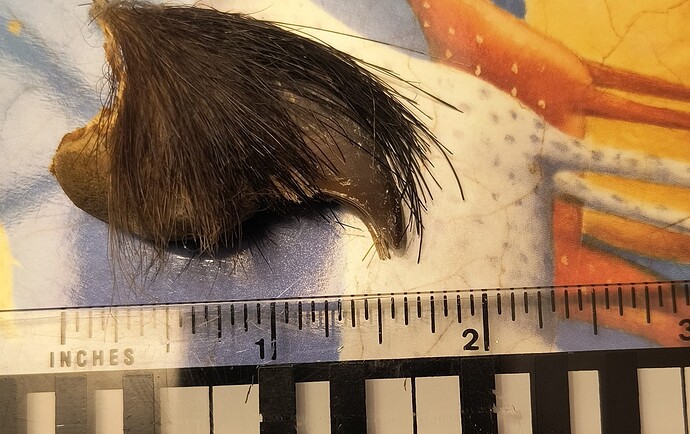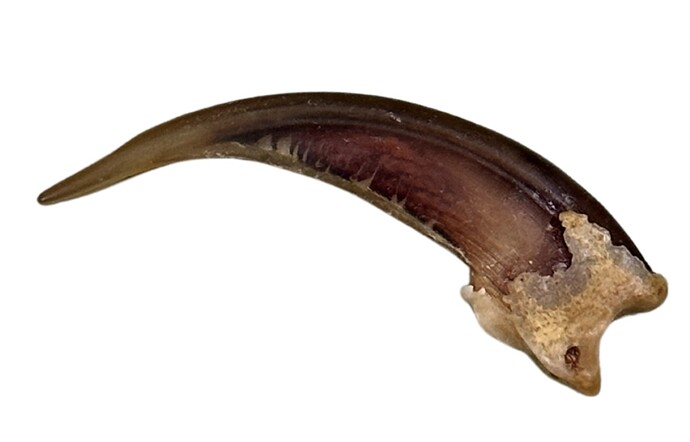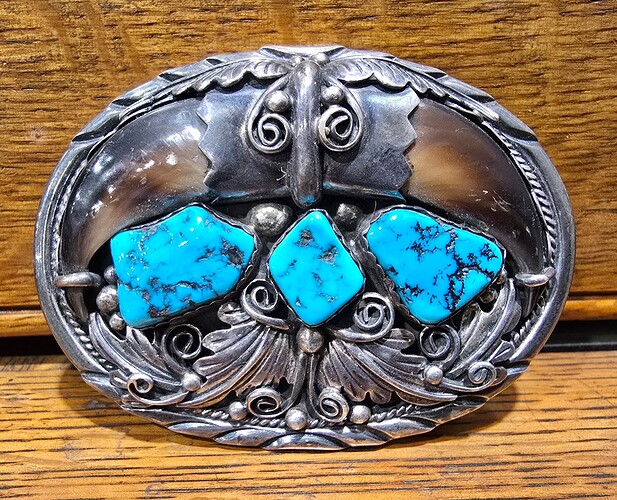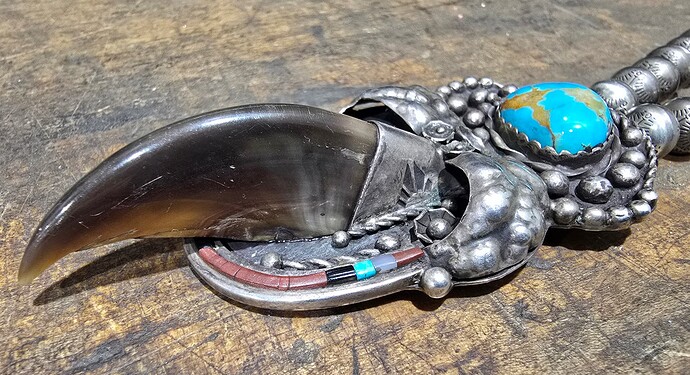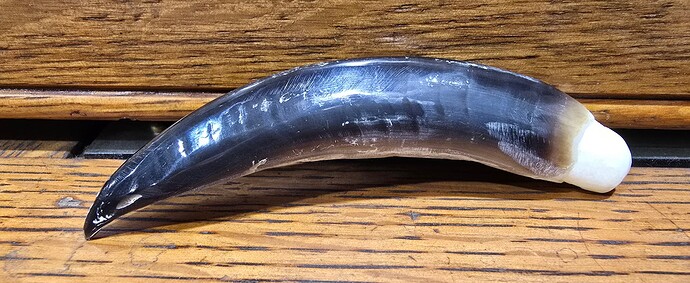I know nothing about bear claw jewelry. Recently a friend asked me to look at her grandma’s Native American jewelry. She sent me some picture of several pieces with bear (?) claws. She’d like to sell them but I’m unsure of the law regarding selling pieces with animal parts, especially in California. I’m going to look up the laws regarding selling, but if any of you folks have knowledge about this type of jewelry, please let me know. This is a close-up of a large squash blossom type necklace. I’ve seen acouple pieces by Richard Begay that look similar in style.
Ooooh I love this. THANK YOU. Good you started addressing the legal question … will I be able to export a buckle with a claw when I buy it next year? Curious to hear some answers.
From what I’ve read there are fake (resin?) claws that can be used. Evidently it is difficult to discern from the real thing. My thought is that these are real due to both the appearance, the apparent age and the silverwork. Again my knowledge is minimal😬
Here’s a link to a state by state reference regarding the sale of black bear parts in the US:
State Regulations on sale of Bear Skins (tanned) and Grizzly Bear Rugs or Bearskins or Bear Fur.
nope,easy to test for plastic …melts & smells like any other plastic w/the hot pin. & that’s if one can’t see the real layers inside.
if from an animal,far more likely to be badger.
& age matters,too. if processed before the restrictions,they don’t apply. saw an idiot that cut off all 4 paws from her bear hide so she wouldn’t get in trouble…sigh
Kinda hard to test with only a photo😆. They certainly appear real; and I assume badger claws are, logically, smaller.
I had also heard that if the item was created prior to implementation of the regulation…just like ivory, the item could be owned and sold. Nope…not in California (where this claw jewelry is located)! Years ago a friend of mine who sold vintage NA in CA, had both his business and home raided because he had a vintage ivory and horn pieces! And you don’t argue with these folks!
@newpawn, other than size, is it easy to tell the difference between black bear and badger claws? We don’t see many badger claws out here in the west, I’ve only seen one from a distance…it stood up and hissed at us!
My dad had a bear rug with the head and the claws that he had displayed in our family furniture store; probably bought in MI back in the late '60s /early '70s. Over time various random people wandering throughout the store pulled almost all the claws out of the rug, so dad brought it to reside on the floor at our house. Then our German Shepherd chewed the nose of the bear. I’m not even sure what happened to it after that.
@Bmpdvm I don’t know if this helps since you don’t have the necklace in hand, but this is a claw off of a small taxidermied (not from the rug) bear I have. Maybe it can give you an idea of size. Unfortunately this claw came off when we moved the bear from storage to our house.
Badger claws have a distinct, large radius, are not as wide at the knuckle, and are more elongated than black bear claws, which are the most common (authentic as well as reproduced) claw utilized in this form of fabricated jewelry. Grizzly bear claws are much more valuable, and needless to say, quite larger. Claws from a mature grizzly or brown bear will have an unmistakable “ivory” tone.
Below are photos of a badger claw and black bear claw (Bone Clones) respectively.
Here are examples of black bear claws I can provide placed in Navajo jewelry.
M. Tsosie buckle
Unkown artist crafted necklace
With no intent of derailing @Bmpdvm’s thread, just for educational fun, a couple of polar bear claws. One mounted on a carved piece of walrus ivory, whittled into a polar bear’s head. These were gifted to me by a dear friend of mine in Alaska, an Athapaskan Native, who hunts walrus, polar bear, and seal for his village.
A seal claw from the afformentioned friend.
Thanks @Ravenscry! I’m sure the pieces my friend has is bear. They are large and much thicker at the base. Interesting the Grizzly Bear difference. I think I now know more about claws than I ever thought I would. I’m glad she can sell bear claw jewelry in Nevada…these pieces are not my “cup of tea,” as they say, but they are heavy and very well executed!
I myself am no expert @Bmpdvm, but I have personally handled claws from Kodiak brown bears, grizzly, black, and polar bears. I would feel very confident in saying the claws in the squash are indeed black bear, as has been mentioned.
This form of jewelry isn’t necessarily what I’m passionate about, nor my “cup of tea” either, but there’s no denying the craftsmanship it took to fabricate the piece in it’s entirety.
Have an official answer, if someone is interested ![]()
Have also asked EU customs if there are any problems importing this. Will let you know also their answer.
Gosh, I probably could have asked my nephew for you if I’d have thought of it. He works for ICE in DC (was in ABQ for several years). Brown Bears (also known as grizzlies in the lower 48) are considered endangered, so that would be why you can’t export one with their claws.
ICE is Immigration and Customs Enforcement?
No problem, @Ziacat , we have an answer now &-)
Yes, you are correct, it is.
What would I have done without ChatGPT … LOL. This forum helps me learn so much!
Now I have also received the answer from the EU authorities.
To import a brown bear claw, you always require a CITES certificate (from the vendor) as well as an import paper for the EU.
To import a black bear claw, the same process applies when sending via mail. When you carry the stuff in your own luggage, the CITES certificate is not required.
Cost for an import paper is €41.35.
Welcome to European bureaucracy …

